Case Study: Nursing Management of Acute Appendicitis Post-Op Care
VerifiedAdded on 2022/10/11
|14
|3224
|15
Case Study
AI Summary
This case study analyzes the nursing care plan for a 29-year-old male patient, Josh Kennedy, admitted with acute appendicitis and a history of asthma. The study delves into the pathophysiology of appendicitis, clinical manifestations, and pre-operative considerations. It develops two post-operative nursing diagnoses: acute pain and deficient fluid volume, along with SMART goals for each. The nursing interventions include pain assessment, fluid management, and medication administration (analgesics, antibiotics, and antiemetics), considering the patient's allergies and asthma. The implementation strategies for each goal are detailed, emphasizing patient education, monitoring, and collaboration with the healthcare team. The case study aims to provide a comprehensive understanding of the nursing care required for patients undergoing appendectomy, focusing on evidence-based practice and patient-centered care.
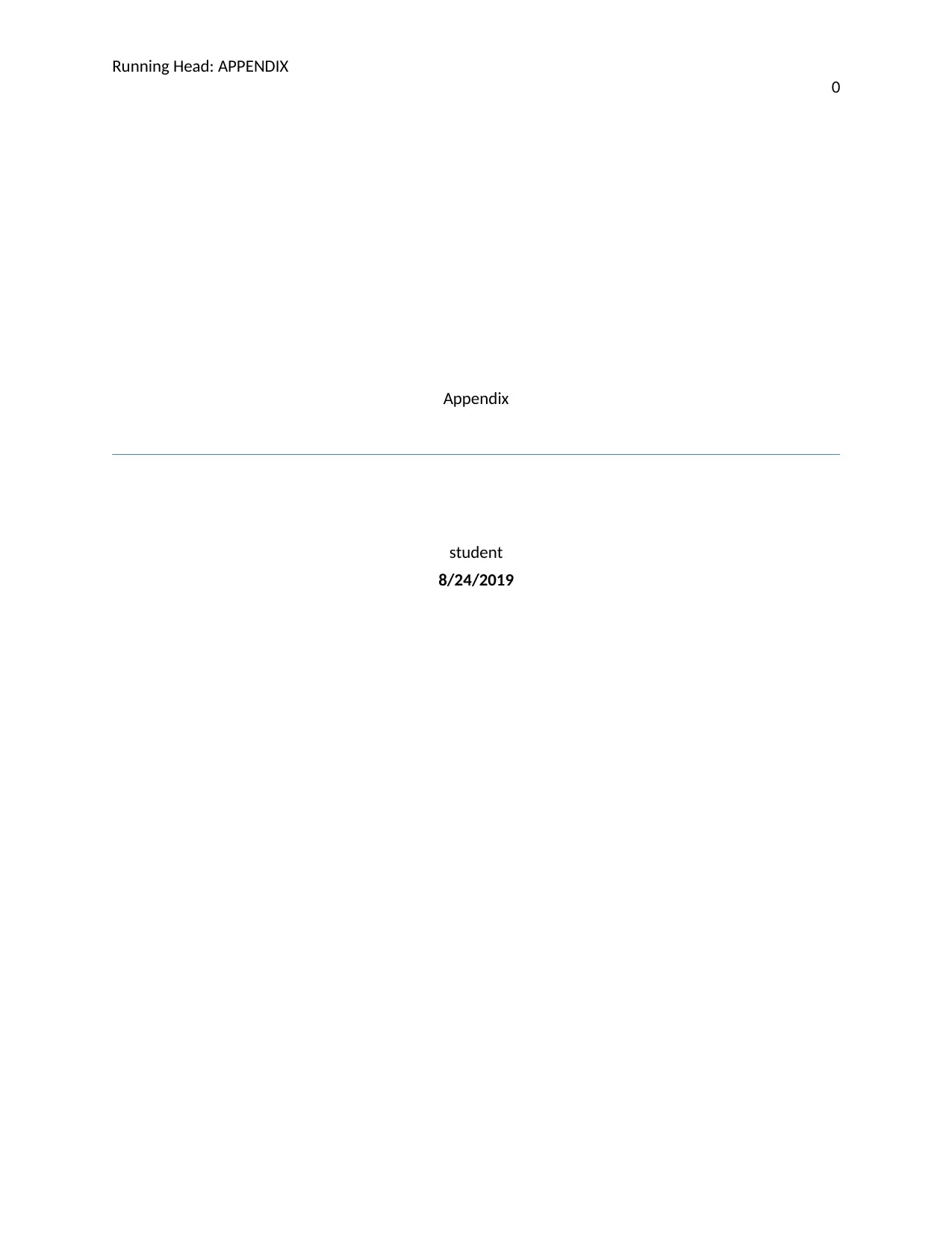
Running Head: APPENDIX
0
Appendix
student
8/24/2019
0
Appendix
student
8/24/2019
Paraphrase This Document
Need a fresh take? Get an instant paraphrase of this document with our AI Paraphraser
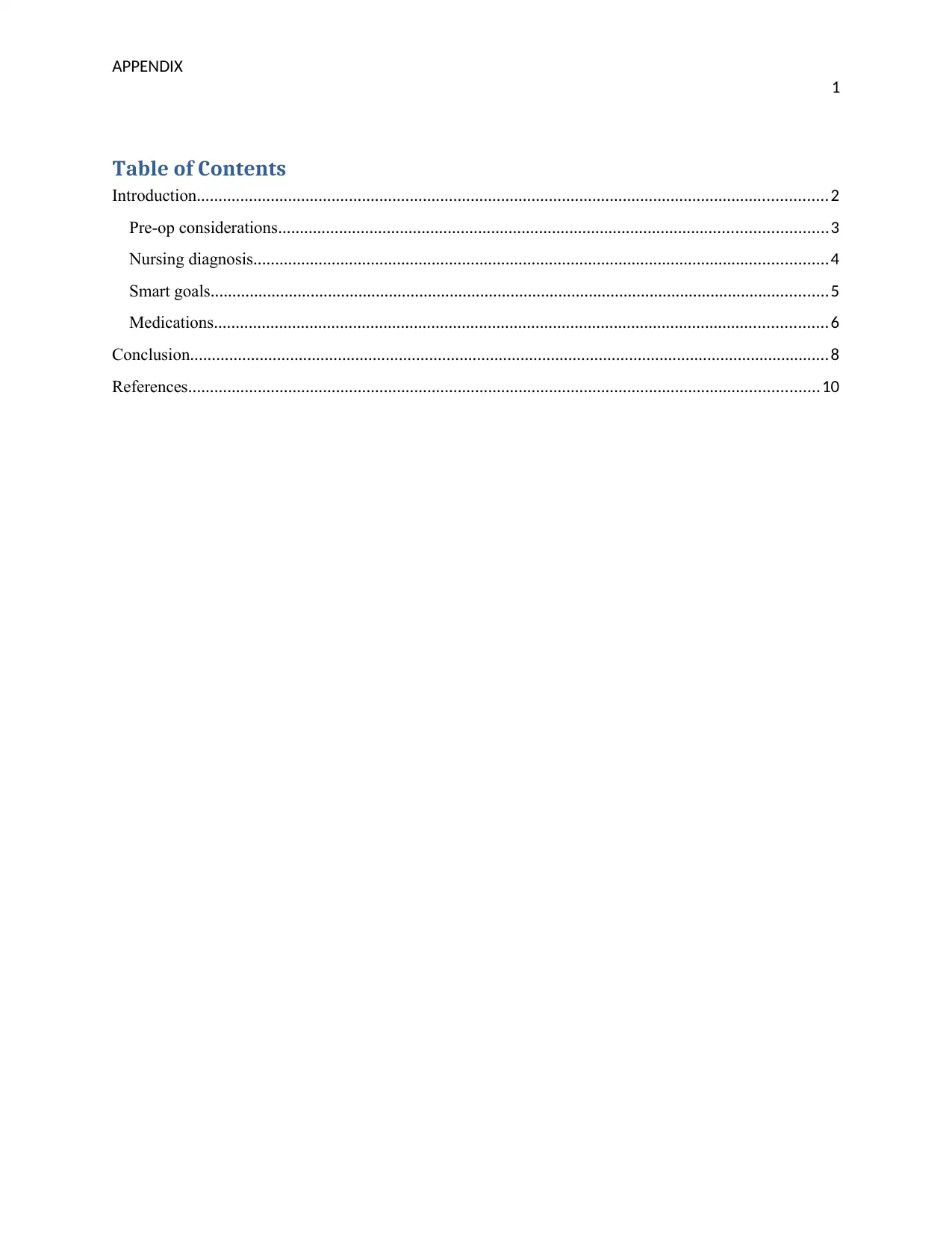
APPENDIX
1
Table of Contents
Introduction.................................................................................................................................................2
Pre-op considerations..............................................................................................................................3
Nursing diagnosis....................................................................................................................................4
Smart goals..............................................................................................................................................5
Medications.............................................................................................................................................6
Conclusion...................................................................................................................................................8
References.................................................................................................................................................10
1
Table of Contents
Introduction.................................................................................................................................................2
Pre-op considerations..............................................................................................................................3
Nursing diagnosis....................................................................................................................................4
Smart goals..............................................................................................................................................5
Medications.............................................................................................................................................6
Conclusion...................................................................................................................................................8
References.................................................................................................................................................10
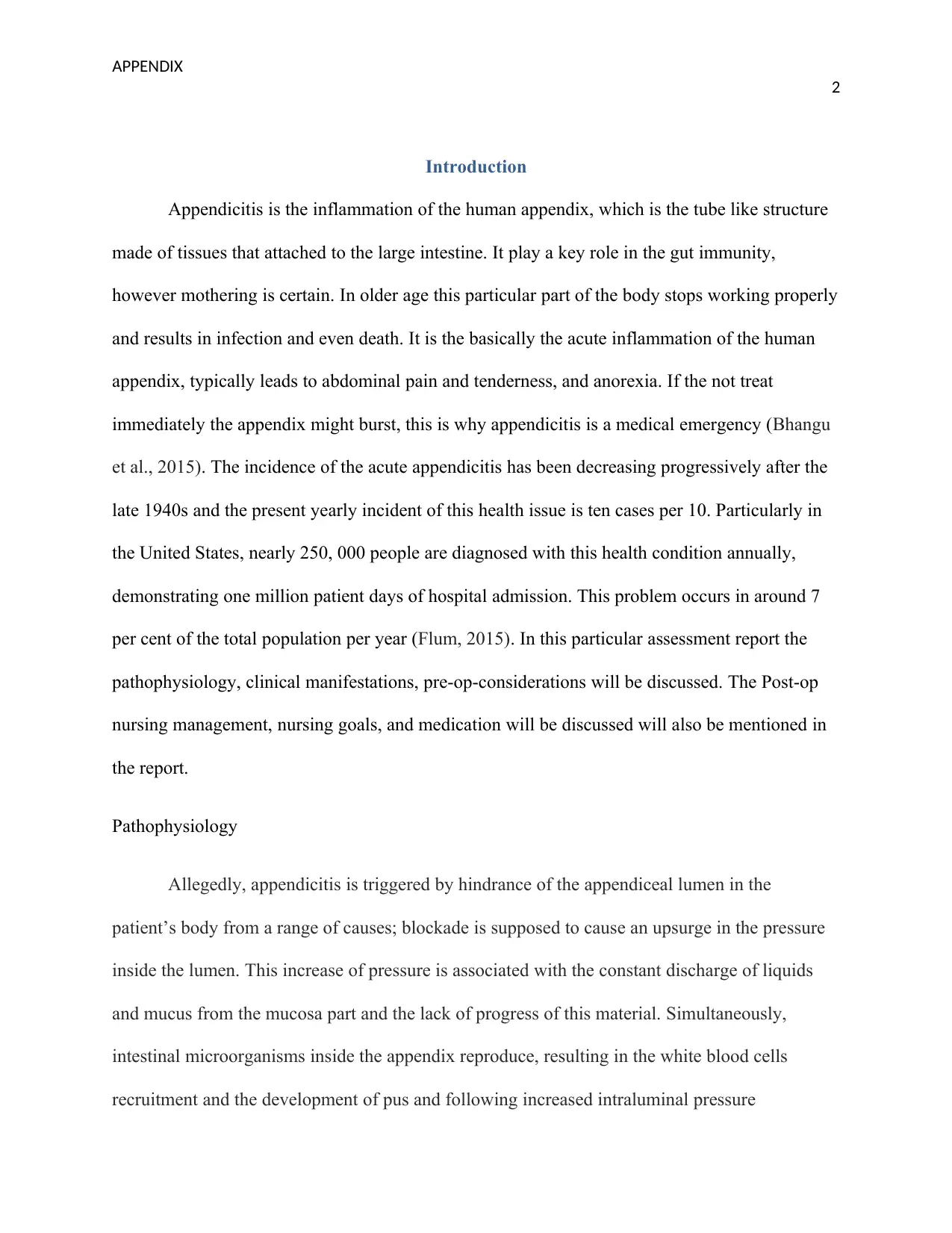
APPENDIX
2
Introduction
Appendicitis is the inflammation of the human appendix, which is the tube like structure
made of tissues that attached to the large intestine. It play a key role in the gut immunity,
however mothering is certain. In older age this particular part of the body stops working properly
and results in infection and even death. It is the basically the acute inflammation of the human
appendix, typically leads to abdominal pain and tenderness, and anorexia. If the not treat
immediately the appendix might burst, this is why appendicitis is a medical emergency (Bhangu
et al., 2015). The incidence of the acute appendicitis has been decreasing progressively after the
late 1940s and the present yearly incident of this health issue is ten cases per 10. Particularly in
the United States, nearly 250, 000 people are diagnosed with this health condition annually,
demonstrating one million patient days of hospital admission. This problem occurs in around 7
per cent of the total population per year (Flum, 2015). In this particular assessment report the
pathophysiology, clinical manifestations, pre-op-considerations will be discussed. The Post-op
nursing management, nursing goals, and medication will be discussed will also be mentioned in
the report.
Pathophysiology
Allegedly, appendicitis is triggered by hindrance of the appendiceal lumen in the
patient’s body from a range of causes; blockade is supposed to cause an upsurge in the pressure
inside the lumen. This increase of pressure is associated with the constant discharge of liquids
and mucus from the mucosa part and the lack of progress of this material. Simultaneously,
intestinal microorganisms inside the appendix reproduce, resulting in the white blood cells
recruitment and the development of pus and following increased intraluminal pressure
2
Introduction
Appendicitis is the inflammation of the human appendix, which is the tube like structure
made of tissues that attached to the large intestine. It play a key role in the gut immunity,
however mothering is certain. In older age this particular part of the body stops working properly
and results in infection and even death. It is the basically the acute inflammation of the human
appendix, typically leads to abdominal pain and tenderness, and anorexia. If the not treat
immediately the appendix might burst, this is why appendicitis is a medical emergency (Bhangu
et al., 2015). The incidence of the acute appendicitis has been decreasing progressively after the
late 1940s and the present yearly incident of this health issue is ten cases per 10. Particularly in
the United States, nearly 250, 000 people are diagnosed with this health condition annually,
demonstrating one million patient days of hospital admission. This problem occurs in around 7
per cent of the total population per year (Flum, 2015). In this particular assessment report the
pathophysiology, clinical manifestations, pre-op-considerations will be discussed. The Post-op
nursing management, nursing goals, and medication will be discussed will also be mentioned in
the report.
Pathophysiology
Allegedly, appendicitis is triggered by hindrance of the appendiceal lumen in the
patient’s body from a range of causes; blockade is supposed to cause an upsurge in the pressure
inside the lumen. This increase of pressure is associated with the constant discharge of liquids
and mucus from the mucosa part and the lack of progress of this material. Simultaneously,
intestinal microorganisms inside the appendix reproduce, resulting in the white blood cells
recruitment and the development of pus and following increased intraluminal pressure
⊘ This is a preview!⊘
Do you want full access?
Subscribe today to unlock all pages.

Trusted by 1+ million students worldwide
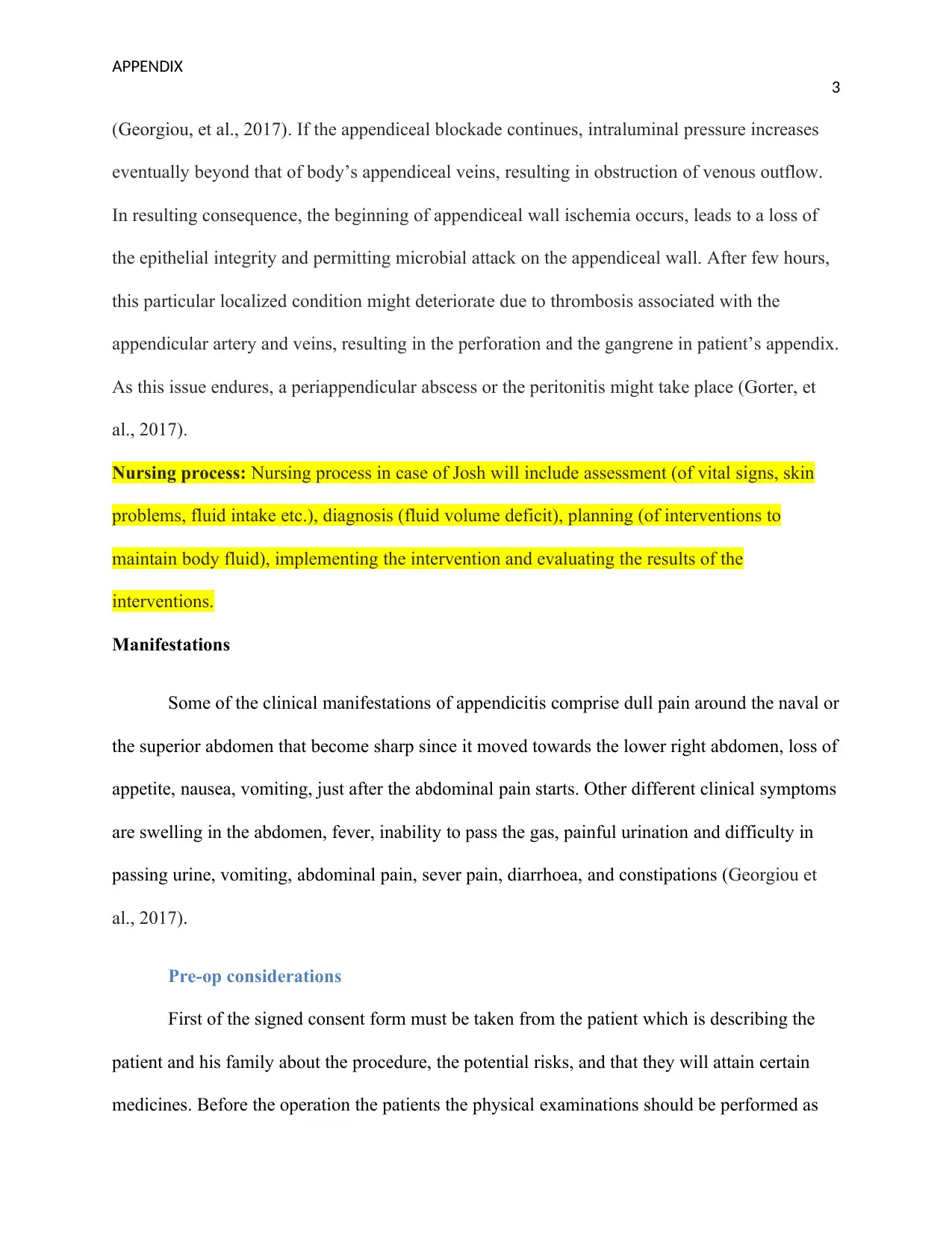
APPENDIX
3
(Georgiou, et al., 2017). If the appendiceal blockade continues, intraluminal pressure increases
eventually beyond that of body’s appendiceal veins, resulting in obstruction of venous outflow.
In resulting consequence, the beginning of appendiceal wall ischemia occurs, leads to a loss of
the epithelial integrity and permitting microbial attack on the appendiceal wall. After few hours,
this particular localized condition might deteriorate due to thrombosis associated with the
appendicular artery and veins, resulting in the perforation and the gangrene in patient’s appendix.
As this issue endures, a periappendicular abscess or the peritonitis might take place (Gorter, et
al., 2017).
Nursing process: Nursing process in case of Josh will include assessment (of vital signs, skin
problems, fluid intake etc.), diagnosis (fluid volume deficit), planning (of interventions to
maintain body fluid), implementing the intervention and evaluating the results of the
interventions.
Manifestations
Some of the clinical manifestations of appendicitis comprise dull pain around the naval or
the superior abdomen that become sharp since it moved towards the lower right abdomen, loss of
appetite, nausea, vomiting, just after the abdominal pain starts. Other different clinical symptoms
are swelling in the abdomen, fever, inability to pass the gas, painful urination and difficulty in
passing urine, vomiting, abdominal pain, sever pain, diarrhoea, and constipations (Georgiou et
al., 2017).
Pre-op considerations
First of the signed consent form must be taken from the patient which is describing the
patient and his family about the procedure, the potential risks, and that they will attain certain
medicines. Before the operation the patients the physical examinations should be performed as
3
(Georgiou, et al., 2017). If the appendiceal blockade continues, intraluminal pressure increases
eventually beyond that of body’s appendiceal veins, resulting in obstruction of venous outflow.
In resulting consequence, the beginning of appendiceal wall ischemia occurs, leads to a loss of
the epithelial integrity and permitting microbial attack on the appendiceal wall. After few hours,
this particular localized condition might deteriorate due to thrombosis associated with the
appendicular artery and veins, resulting in the perforation and the gangrene in patient’s appendix.
As this issue endures, a periappendicular abscess or the peritonitis might take place (Gorter, et
al., 2017).
Nursing process: Nursing process in case of Josh will include assessment (of vital signs, skin
problems, fluid intake etc.), diagnosis (fluid volume deficit), planning (of interventions to
maintain body fluid), implementing the intervention and evaluating the results of the
interventions.
Manifestations
Some of the clinical manifestations of appendicitis comprise dull pain around the naval or
the superior abdomen that become sharp since it moved towards the lower right abdomen, loss of
appetite, nausea, vomiting, just after the abdominal pain starts. Other different clinical symptoms
are swelling in the abdomen, fever, inability to pass the gas, painful urination and difficulty in
passing urine, vomiting, abdominal pain, sever pain, diarrhoea, and constipations (Georgiou et
al., 2017).
Pre-op considerations
First of the signed consent form must be taken from the patient which is describing the
patient and his family about the procedure, the potential risks, and that they will attain certain
medicines. Before the operation the patients the physical examinations should be performed as
Paraphrase This Document
Need a fresh take? Get an instant paraphrase of this document with our AI Paraphraser
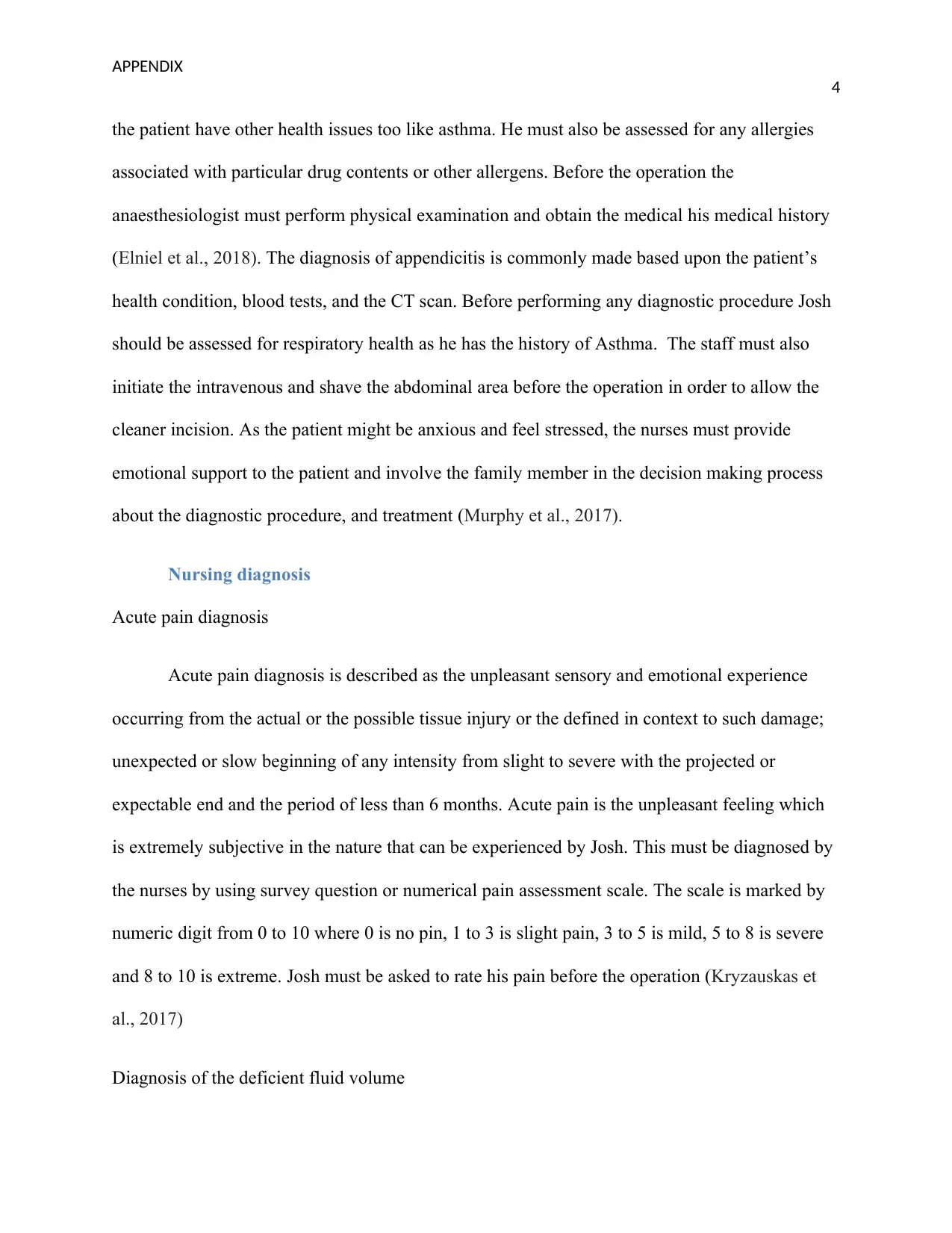
APPENDIX
4
the patient have other health issues too like asthma. He must also be assessed for any allergies
associated with particular drug contents or other allergens. Before the operation the
anaesthesiologist must perform physical examination and obtain the medical his medical history
(Elniel et al., 2018). The diagnosis of appendicitis is commonly made based upon the patient’s
health condition, blood tests, and the CT scan. Before performing any diagnostic procedure Josh
should be assessed for respiratory health as he has the history of Asthma. The staff must also
initiate the intravenous and shave the abdominal area before the operation in order to allow the
cleaner incision. As the patient might be anxious and feel stressed, the nurses must provide
emotional support to the patient and involve the family member in the decision making process
about the diagnostic procedure, and treatment (Murphy et al., 2017).
Nursing diagnosis
Acute pain diagnosis
Acute pain diagnosis is described as the unpleasant sensory and emotional experience
occurring from the actual or the possible tissue injury or the defined in context to such damage;
unexpected or slow beginning of any intensity from slight to severe with the projected or
expectable end and the period of less than 6 months. Acute pain is the unpleasant feeling which
is extremely subjective in the nature that can be experienced by Josh. This must be diagnosed by
the nurses by using survey question or numerical pain assessment scale. The scale is marked by
numeric digit from 0 to 10 where 0 is no pin, 1 to 3 is slight pain, 3 to 5 is mild, 5 to 8 is severe
and 8 to 10 is extreme. Josh must be asked to rate his pain before the operation (Kryzauskas et
al., 2017)
Diagnosis of the deficient fluid volume
4
the patient have other health issues too like asthma. He must also be assessed for any allergies
associated with particular drug contents or other allergens. Before the operation the
anaesthesiologist must perform physical examination and obtain the medical his medical history
(Elniel et al., 2018). The diagnosis of appendicitis is commonly made based upon the patient’s
health condition, blood tests, and the CT scan. Before performing any diagnostic procedure Josh
should be assessed for respiratory health as he has the history of Asthma. The staff must also
initiate the intravenous and shave the abdominal area before the operation in order to allow the
cleaner incision. As the patient might be anxious and feel stressed, the nurses must provide
emotional support to the patient and involve the family member in the decision making process
about the diagnostic procedure, and treatment (Murphy et al., 2017).
Nursing diagnosis
Acute pain diagnosis
Acute pain diagnosis is described as the unpleasant sensory and emotional experience
occurring from the actual or the possible tissue injury or the defined in context to such damage;
unexpected or slow beginning of any intensity from slight to severe with the projected or
expectable end and the period of less than 6 months. Acute pain is the unpleasant feeling which
is extremely subjective in the nature that can be experienced by Josh. This must be diagnosed by
the nurses by using survey question or numerical pain assessment scale. The scale is marked by
numeric digit from 0 to 10 where 0 is no pin, 1 to 3 is slight pain, 3 to 5 is mild, 5 to 8 is severe
and 8 to 10 is extreme. Josh must be asked to rate his pain before the operation (Kryzauskas et
al., 2017)
Diagnosis of the deficient fluid volume
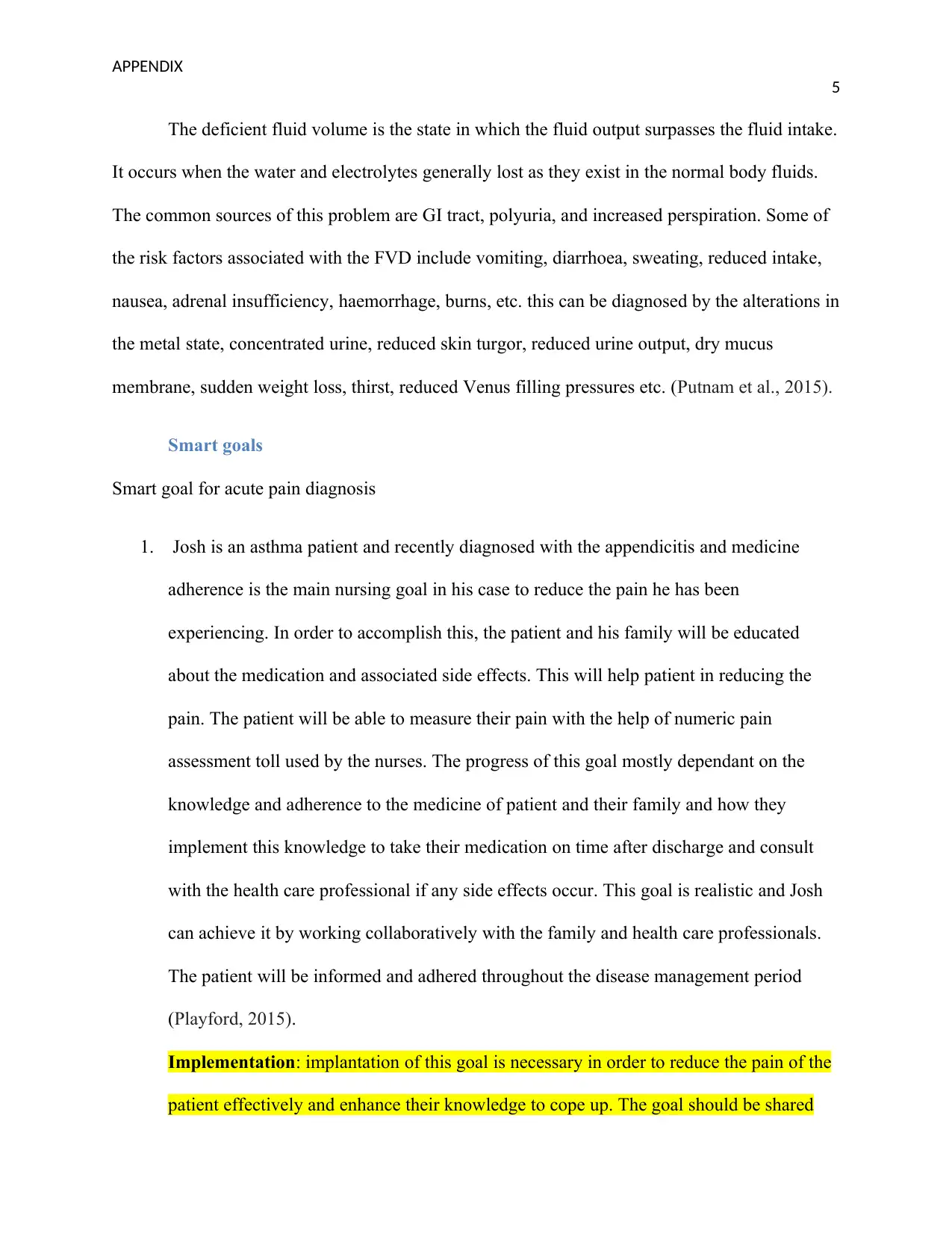
APPENDIX
5
The deficient fluid volume is the state in which the fluid output surpasses the fluid intake.
It occurs when the water and electrolytes generally lost as they exist in the normal body fluids.
The common sources of this problem are GI tract, polyuria, and increased perspiration. Some of
the risk factors associated with the FVD include vomiting, diarrhoea, sweating, reduced intake,
nausea, adrenal insufficiency, haemorrhage, burns, etc. this can be diagnosed by the alterations in
the metal state, concentrated urine, reduced skin turgor, reduced urine output, dry mucus
membrane, sudden weight loss, thirst, reduced Venus filling pressures etc. (Putnam et al., 2015).
Smart goals
Smart goal for acute pain diagnosis
1. Josh is an asthma patient and recently diagnosed with the appendicitis and medicine
adherence is the main nursing goal in his case to reduce the pain he has been
experiencing. In order to accomplish this, the patient and his family will be educated
about the medication and associated side effects. This will help patient in reducing the
pain. The patient will be able to measure their pain with the help of numeric pain
assessment toll used by the nurses. The progress of this goal mostly dependant on the
knowledge and adherence to the medicine of patient and their family and how they
implement this knowledge to take their medication on time after discharge and consult
with the health care professional if any side effects occur. This goal is realistic and Josh
can achieve it by working collaboratively with the family and health care professionals.
The patient will be informed and adhered throughout the disease management period
(Playford, 2015).
Implementation: implantation of this goal is necessary in order to reduce the pain of the
patient effectively and enhance their knowledge to cope up. The goal should be shared
5
The deficient fluid volume is the state in which the fluid output surpasses the fluid intake.
It occurs when the water and electrolytes generally lost as they exist in the normal body fluids.
The common sources of this problem are GI tract, polyuria, and increased perspiration. Some of
the risk factors associated with the FVD include vomiting, diarrhoea, sweating, reduced intake,
nausea, adrenal insufficiency, haemorrhage, burns, etc. this can be diagnosed by the alterations in
the metal state, concentrated urine, reduced skin turgor, reduced urine output, dry mucus
membrane, sudden weight loss, thirst, reduced Venus filling pressures etc. (Putnam et al., 2015).
Smart goals
Smart goal for acute pain diagnosis
1. Josh is an asthma patient and recently diagnosed with the appendicitis and medicine
adherence is the main nursing goal in his case to reduce the pain he has been
experiencing. In order to accomplish this, the patient and his family will be educated
about the medication and associated side effects. This will help patient in reducing the
pain. The patient will be able to measure their pain with the help of numeric pain
assessment toll used by the nurses. The progress of this goal mostly dependant on the
knowledge and adherence to the medicine of patient and their family and how they
implement this knowledge to take their medication on time after discharge and consult
with the health care professional if any side effects occur. This goal is realistic and Josh
can achieve it by working collaboratively with the family and health care professionals.
The patient will be informed and adhered throughout the disease management period
(Playford, 2015).
Implementation: implantation of this goal is necessary in order to reduce the pain of the
patient effectively and enhance their knowledge to cope up. The goal should be shared
⊘ This is a preview!⊘
Do you want full access?
Subscribe today to unlock all pages.

Trusted by 1+ million students worldwide
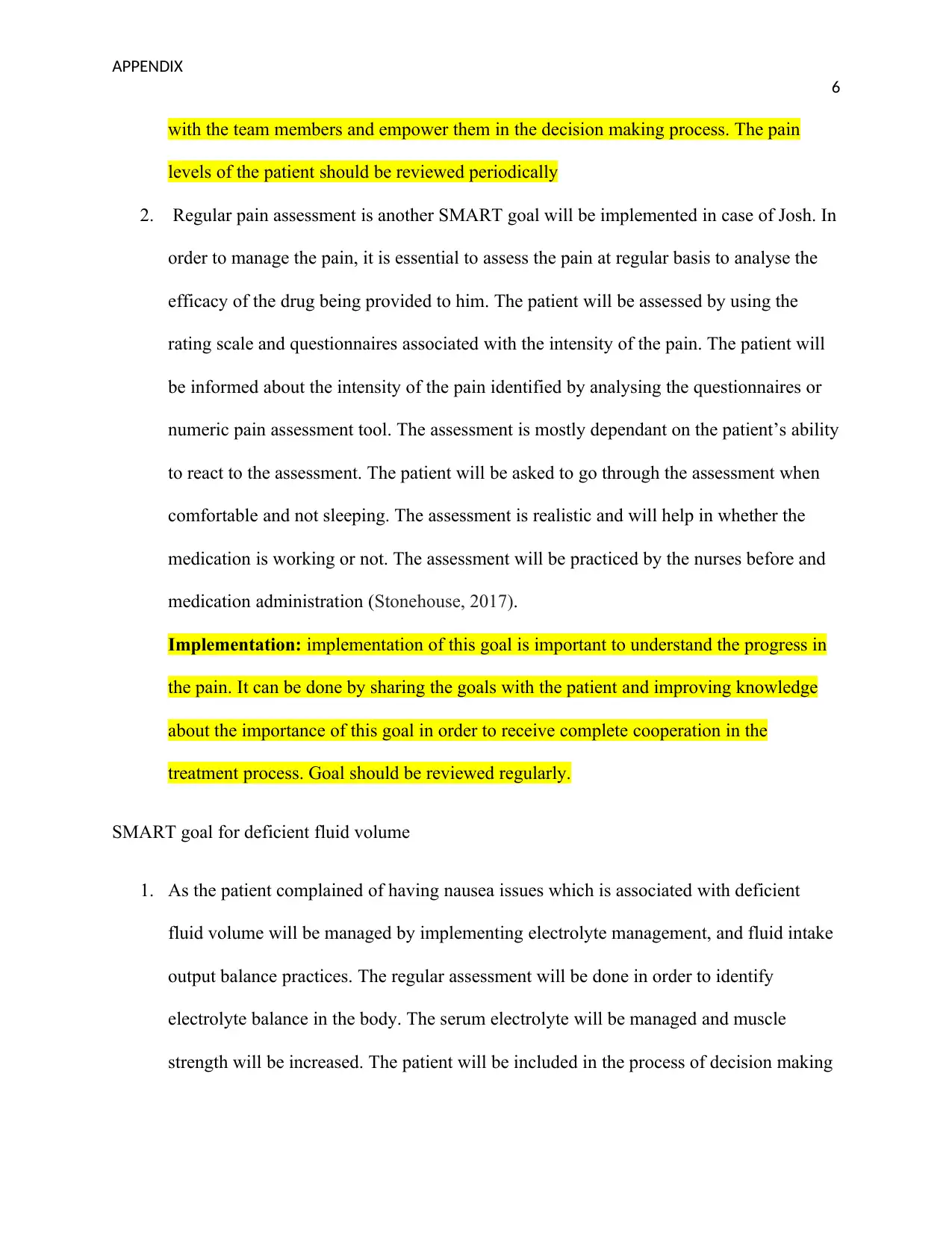
APPENDIX
6
with the team members and empower them in the decision making process. The pain
levels of the patient should be reviewed periodically
2. Regular pain assessment is another SMART goal will be implemented in case of Josh. In
order to manage the pain, it is essential to assess the pain at regular basis to analyse the
efficacy of the drug being provided to him. The patient will be assessed by using the
rating scale and questionnaires associated with the intensity of the pain. The patient will
be informed about the intensity of the pain identified by analysing the questionnaires or
numeric pain assessment tool. The assessment is mostly dependant on the patient’s ability
to react to the assessment. The patient will be asked to go through the assessment when
comfortable and not sleeping. The assessment is realistic and will help in whether the
medication is working or not. The assessment will be practiced by the nurses before and
medication administration (Stonehouse, 2017).
Implementation: implementation of this goal is important to understand the progress in
the pain. It can be done by sharing the goals with the patient and improving knowledge
about the importance of this goal in order to receive complete cooperation in the
treatment process. Goal should be reviewed regularly.
SMART goal for deficient fluid volume
1. As the patient complained of having nausea issues which is associated with deficient
fluid volume will be managed by implementing electrolyte management, and fluid intake
output balance practices. The regular assessment will be done in order to identify
electrolyte balance in the body. The serum electrolyte will be managed and muscle
strength will be increased. The patient will be included in the process of decision making
6
with the team members and empower them in the decision making process. The pain
levels of the patient should be reviewed periodically
2. Regular pain assessment is another SMART goal will be implemented in case of Josh. In
order to manage the pain, it is essential to assess the pain at regular basis to analyse the
efficacy of the drug being provided to him. The patient will be assessed by using the
rating scale and questionnaires associated with the intensity of the pain. The patient will
be informed about the intensity of the pain identified by analysing the questionnaires or
numeric pain assessment tool. The assessment is mostly dependant on the patient’s ability
to react to the assessment. The patient will be asked to go through the assessment when
comfortable and not sleeping. The assessment is realistic and will help in whether the
medication is working or not. The assessment will be practiced by the nurses before and
medication administration (Stonehouse, 2017).
Implementation: implementation of this goal is important to understand the progress in
the pain. It can be done by sharing the goals with the patient and improving knowledge
about the importance of this goal in order to receive complete cooperation in the
treatment process. Goal should be reviewed regularly.
SMART goal for deficient fluid volume
1. As the patient complained of having nausea issues which is associated with deficient
fluid volume will be managed by implementing electrolyte management, and fluid intake
output balance practices. The regular assessment will be done in order to identify
electrolyte balance in the body. The serum electrolyte will be managed and muscle
strength will be increased. The patient will be included in the process of decision making
Paraphrase This Document
Need a fresh take? Get an instant paraphrase of this document with our AI Paraphraser
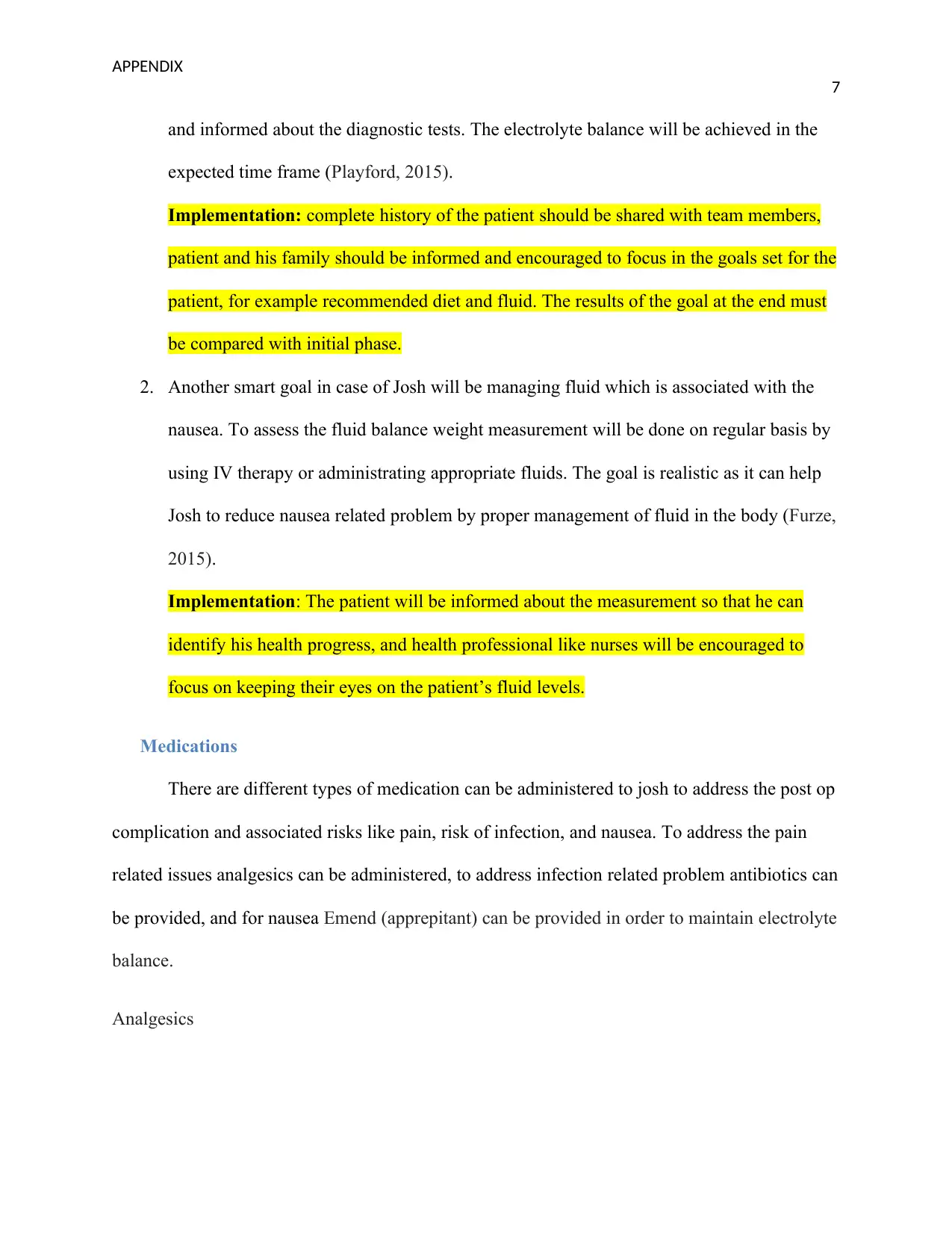
APPENDIX
7
and informed about the diagnostic tests. The electrolyte balance will be achieved in the
expected time frame (Playford, 2015).
Implementation: complete history of the patient should be shared with team members,
patient and his family should be informed and encouraged to focus in the goals set for the
patient, for example recommended diet and fluid. The results of the goal at the end must
be compared with initial phase.
2. Another smart goal in case of Josh will be managing fluid which is associated with the
nausea. To assess the fluid balance weight measurement will be done on regular basis by
using IV therapy or administrating appropriate fluids. The goal is realistic as it can help
Josh to reduce nausea related problem by proper management of fluid in the body (Furze,
2015).
Implementation: The patient will be informed about the measurement so that he can
identify his health progress, and health professional like nurses will be encouraged to
focus on keeping their eyes on the patient’s fluid levels.
Medications
There are different types of medication can be administered to josh to address the post op
complication and associated risks like pain, risk of infection, and nausea. To address the pain
related issues analgesics can be administered, to address infection related problem antibiotics can
be provided, and for nausea Emend (apprepitant) can be provided in order to maintain electrolyte
balance.
Analgesics
7
and informed about the diagnostic tests. The electrolyte balance will be achieved in the
expected time frame (Playford, 2015).
Implementation: complete history of the patient should be shared with team members,
patient and his family should be informed and encouraged to focus in the goals set for the
patient, for example recommended diet and fluid. The results of the goal at the end must
be compared with initial phase.
2. Another smart goal in case of Josh will be managing fluid which is associated with the
nausea. To assess the fluid balance weight measurement will be done on regular basis by
using IV therapy or administrating appropriate fluids. The goal is realistic as it can help
Josh to reduce nausea related problem by proper management of fluid in the body (Furze,
2015).
Implementation: The patient will be informed about the measurement so that he can
identify his health progress, and health professional like nurses will be encouraged to
focus on keeping their eyes on the patient’s fluid levels.
Medications
There are different types of medication can be administered to josh to address the post op
complication and associated risks like pain, risk of infection, and nausea. To address the pain
related issues analgesics can be administered, to address infection related problem antibiotics can
be provided, and for nausea Emend (apprepitant) can be provided in order to maintain electrolyte
balance.
Analgesics
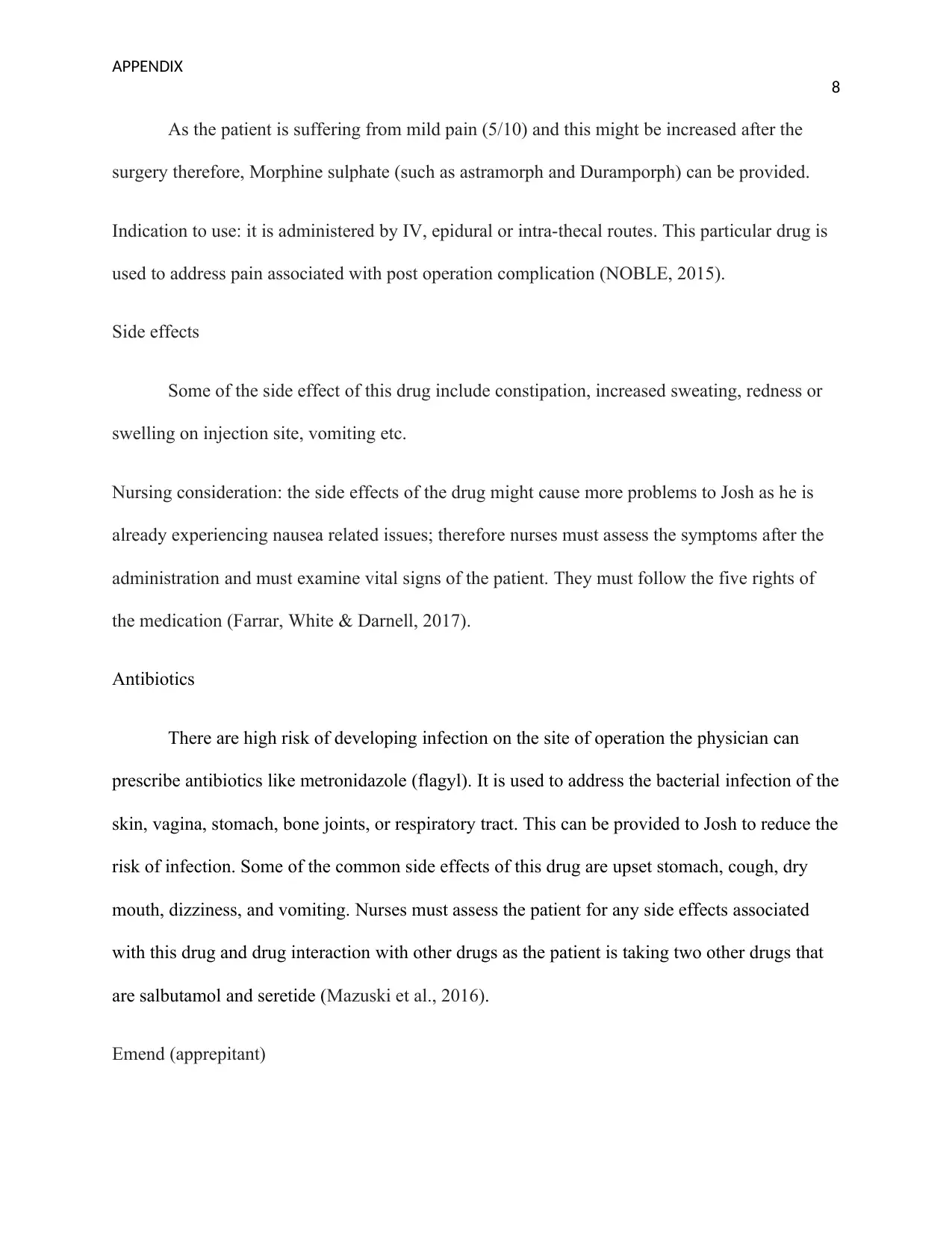
APPENDIX
8
As the patient is suffering from mild pain (5/10) and this might be increased after the
surgery therefore, Morphine sulphate (such as astramorph and Duramporph) can be provided.
Indication to use: it is administered by IV, epidural or intra-thecal routes. This particular drug is
used to address pain associated with post operation complication (NOBLE, 2015).
Side effects
Some of the side effect of this drug include constipation, increased sweating, redness or
swelling on injection site, vomiting etc.
Nursing consideration: the side effects of the drug might cause more problems to Josh as he is
already experiencing nausea related issues; therefore nurses must assess the symptoms after the
administration and must examine vital signs of the patient. They must follow the five rights of
the medication (Farrar, White & Darnell, 2017).
Antibiotics
There are high risk of developing infection on the site of operation the physician can
prescribe antibiotics like metronidazole (flagyl). It is used to address the bacterial infection of the
skin, vagina, stomach, bone joints, or respiratory tract. This can be provided to Josh to reduce the
risk of infection. Some of the common side effects of this drug are upset stomach, cough, dry
mouth, dizziness, and vomiting. Nurses must assess the patient for any side effects associated
with this drug and drug interaction with other drugs as the patient is taking two other drugs that
are salbutamol and seretide (Mazuski et al., 2016).
Emend (apprepitant)
8
As the patient is suffering from mild pain (5/10) and this might be increased after the
surgery therefore, Morphine sulphate (such as astramorph and Duramporph) can be provided.
Indication to use: it is administered by IV, epidural or intra-thecal routes. This particular drug is
used to address pain associated with post operation complication (NOBLE, 2015).
Side effects
Some of the side effect of this drug include constipation, increased sweating, redness or
swelling on injection site, vomiting etc.
Nursing consideration: the side effects of the drug might cause more problems to Josh as he is
already experiencing nausea related issues; therefore nurses must assess the symptoms after the
administration and must examine vital signs of the patient. They must follow the five rights of
the medication (Farrar, White & Darnell, 2017).
Antibiotics
There are high risk of developing infection on the site of operation the physician can
prescribe antibiotics like metronidazole (flagyl). It is used to address the bacterial infection of the
skin, vagina, stomach, bone joints, or respiratory tract. This can be provided to Josh to reduce the
risk of infection. Some of the common side effects of this drug are upset stomach, cough, dry
mouth, dizziness, and vomiting. Nurses must assess the patient for any side effects associated
with this drug and drug interaction with other drugs as the patient is taking two other drugs that
are salbutamol and seretide (Mazuski et al., 2016).
Emend (apprepitant)
⊘ This is a preview!⊘
Do you want full access?
Subscribe today to unlock all pages.

Trusted by 1+ million students worldwide
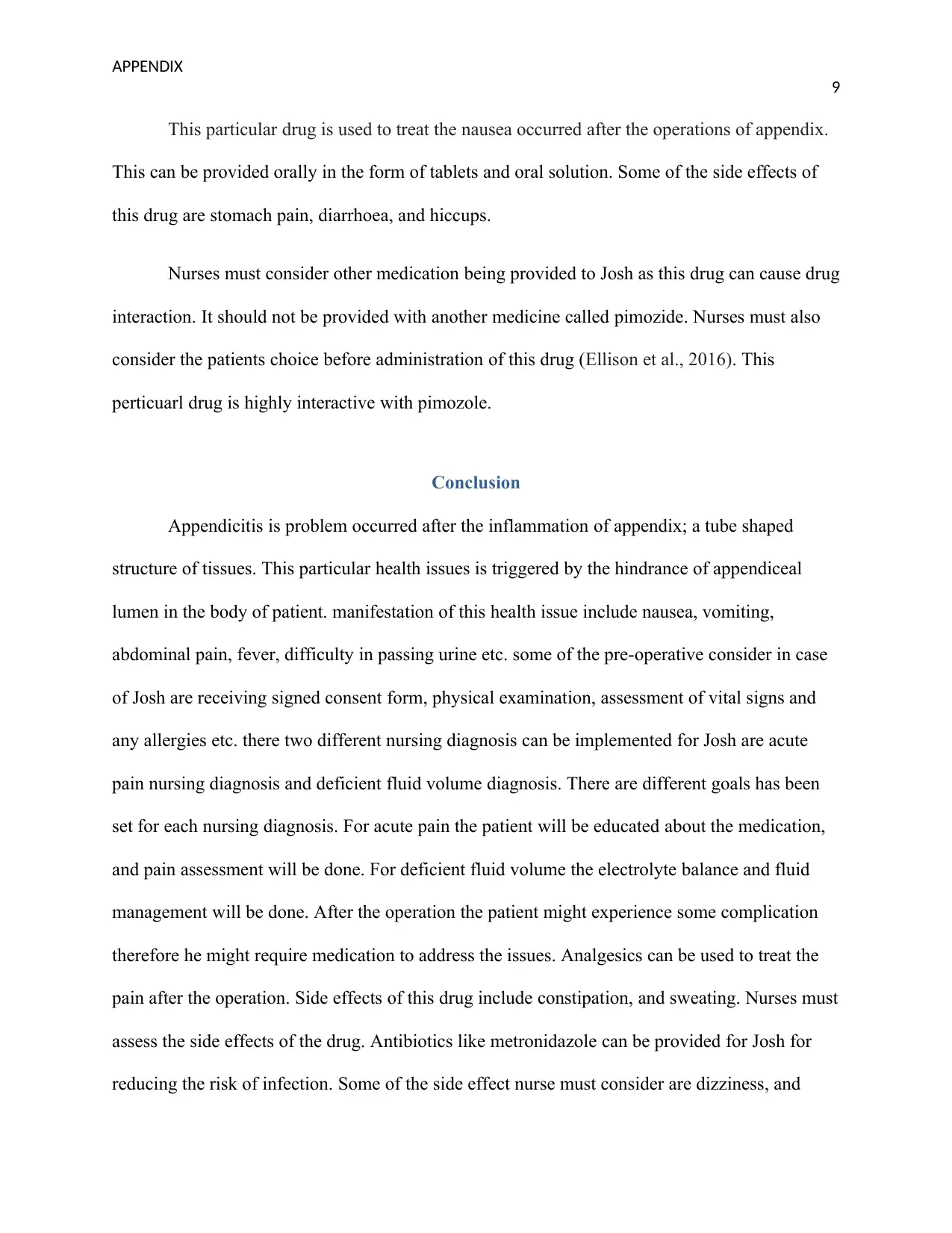
APPENDIX
9
This particular drug is used to treat the nausea occurred after the operations of appendix.
This can be provided orally in the form of tablets and oral solution. Some of the side effects of
this drug are stomach pain, diarrhoea, and hiccups.
Nurses must consider other medication being provided to Josh as this drug can cause drug
interaction. It should not be provided with another medicine called pimozide. Nurses must also
consider the patients choice before administration of this drug (Ellison et al., 2016). This
perticuarl drug is highly interactive with pimozole.
Conclusion
Appendicitis is problem occurred after the inflammation of appendix; a tube shaped
structure of tissues. This particular health issues is triggered by the hindrance of appendiceal
lumen in the body of patient. manifestation of this health issue include nausea, vomiting,
abdominal pain, fever, difficulty in passing urine etc. some of the pre-operative consider in case
of Josh are receiving signed consent form, physical examination, assessment of vital signs and
any allergies etc. there two different nursing diagnosis can be implemented for Josh are acute
pain nursing diagnosis and deficient fluid volume diagnosis. There are different goals has been
set for each nursing diagnosis. For acute pain the patient will be educated about the medication,
and pain assessment will be done. For deficient fluid volume the electrolyte balance and fluid
management will be done. After the operation the patient might experience some complication
therefore he might require medication to address the issues. Analgesics can be used to treat the
pain after the operation. Side effects of this drug include constipation, and sweating. Nurses must
assess the side effects of the drug. Antibiotics like metronidazole can be provided for Josh for
reducing the risk of infection. Some of the side effect nurse must consider are dizziness, and
9
This particular drug is used to treat the nausea occurred after the operations of appendix.
This can be provided orally in the form of tablets and oral solution. Some of the side effects of
this drug are stomach pain, diarrhoea, and hiccups.
Nurses must consider other medication being provided to Josh as this drug can cause drug
interaction. It should not be provided with another medicine called pimozide. Nurses must also
consider the patients choice before administration of this drug (Ellison et al., 2016). This
perticuarl drug is highly interactive with pimozole.
Conclusion
Appendicitis is problem occurred after the inflammation of appendix; a tube shaped
structure of tissues. This particular health issues is triggered by the hindrance of appendiceal
lumen in the body of patient. manifestation of this health issue include nausea, vomiting,
abdominal pain, fever, difficulty in passing urine etc. some of the pre-operative consider in case
of Josh are receiving signed consent form, physical examination, assessment of vital signs and
any allergies etc. there two different nursing diagnosis can be implemented for Josh are acute
pain nursing diagnosis and deficient fluid volume diagnosis. There are different goals has been
set for each nursing diagnosis. For acute pain the patient will be educated about the medication,
and pain assessment will be done. For deficient fluid volume the electrolyte balance and fluid
management will be done. After the operation the patient might experience some complication
therefore he might require medication to address the issues. Analgesics can be used to treat the
pain after the operation. Side effects of this drug include constipation, and sweating. Nurses must
assess the side effects of the drug. Antibiotics like metronidazole can be provided for Josh for
reducing the risk of infection. Some of the side effect nurse must consider are dizziness, and
Paraphrase This Document
Need a fresh take? Get an instant paraphrase of this document with our AI Paraphraser
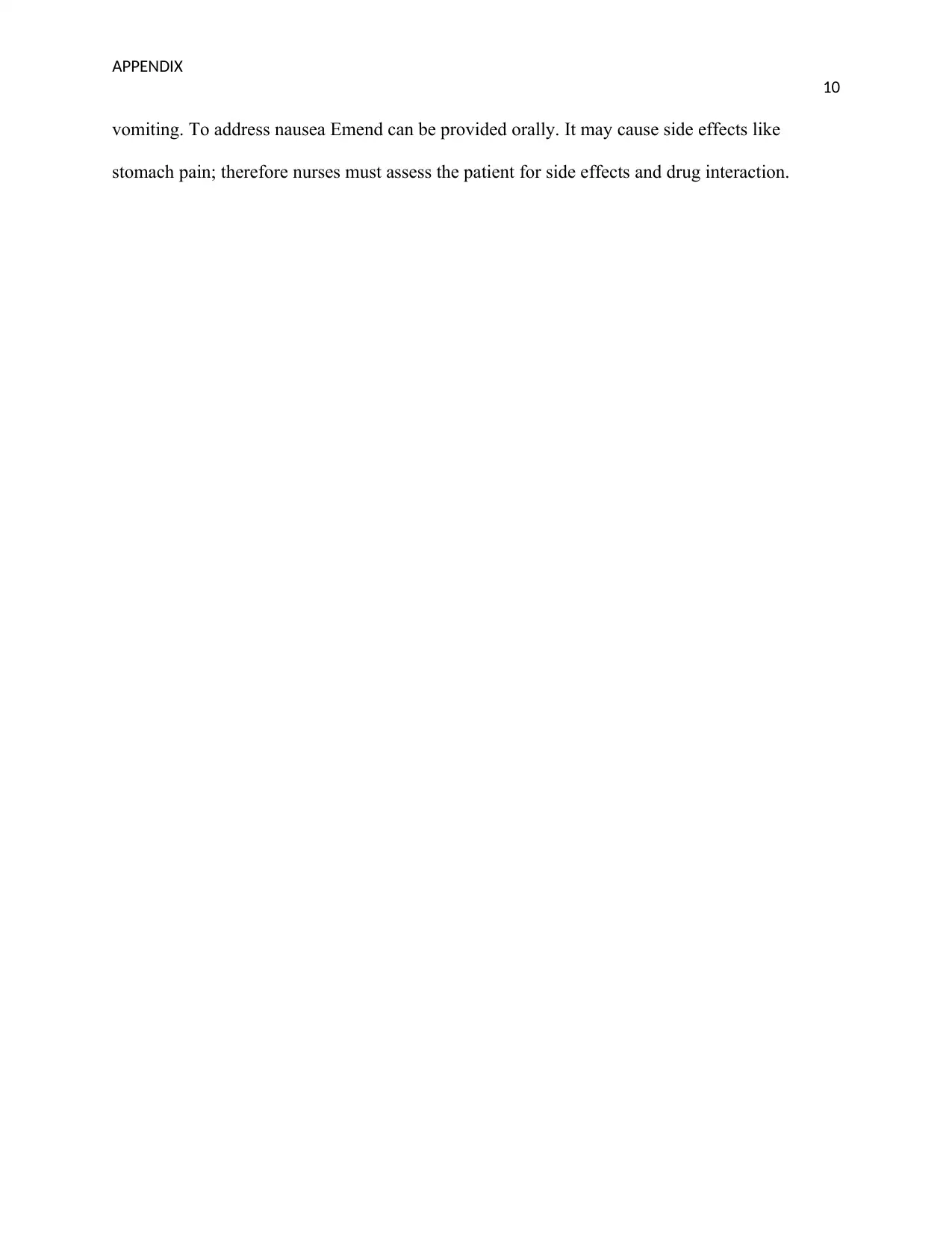
APPENDIX
10
vomiting. To address nausea Emend can be provided orally. It may cause side effects like
stomach pain; therefore nurses must assess the patient for side effects and drug interaction.
10
vomiting. To address nausea Emend can be provided orally. It may cause side effects like
stomach pain; therefore nurses must assess the patient for side effects and drug interaction.
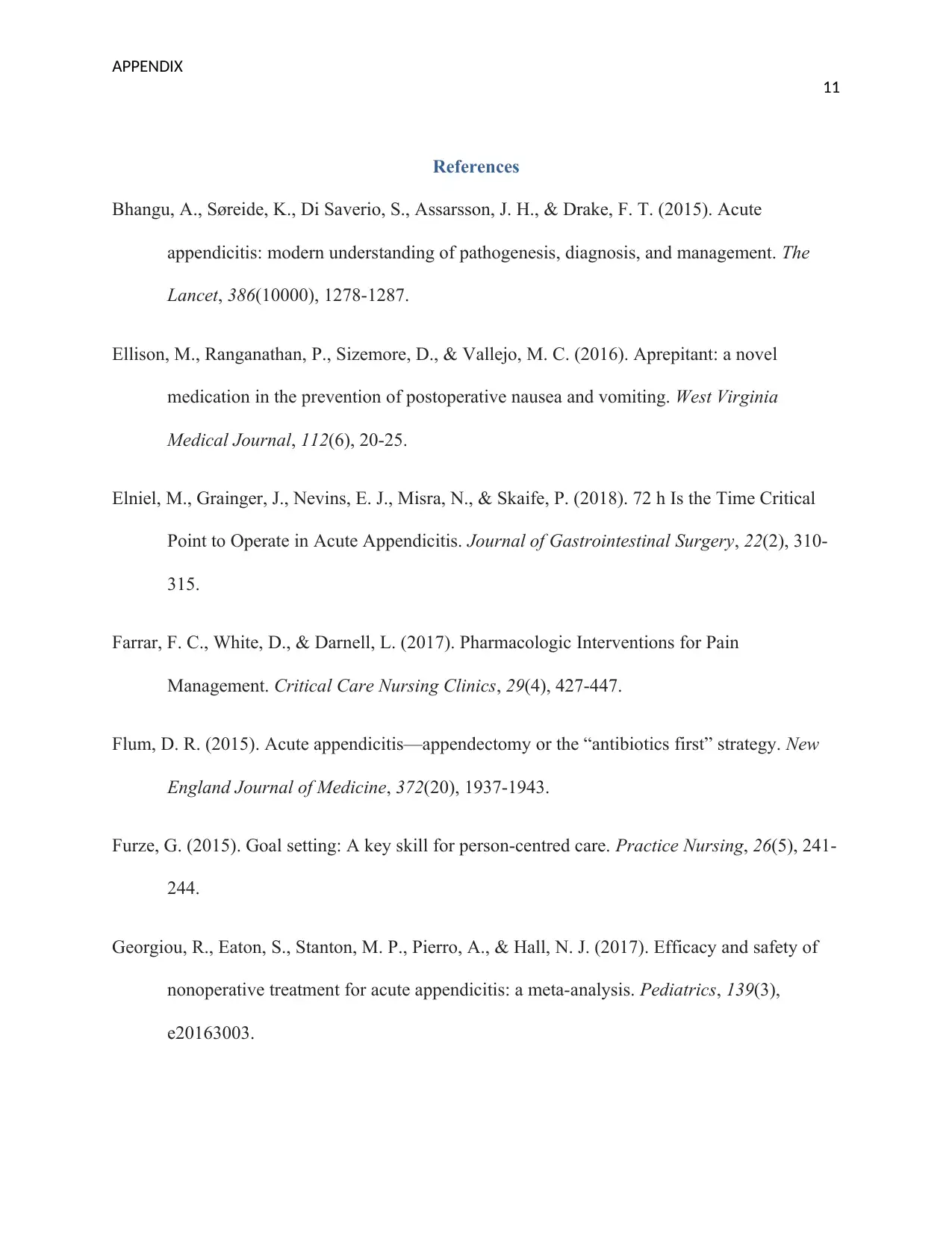
APPENDIX
11
References
Bhangu, A., Søreide, K., Di Saverio, S., Assarsson, J. H., & Drake, F. T. (2015). Acute
appendicitis: modern understanding of pathogenesis, diagnosis, and management. The
Lancet, 386(10000), 1278-1287.
Ellison, M., Ranganathan, P., Sizemore, D., & Vallejo, M. C. (2016). Aprepitant: a novel
medication in the prevention of postoperative nausea and vomiting. West Virginia
Medical Journal, 112(6), 20-25.
Elniel, M., Grainger, J., Nevins, E. J., Misra, N., & Skaife, P. (2018). 72 h Is the Time Critical
Point to Operate in Acute Appendicitis. Journal of Gastrointestinal Surgery, 22(2), 310-
315.
Farrar, F. C., White, D., & Darnell, L. (2017). Pharmacologic Interventions for Pain
Management. Critical Care Nursing Clinics, 29(4), 427-447.
Flum, D. R. (2015). Acute appendicitis—appendectomy or the “antibiotics first” strategy. New
England Journal of Medicine, 372(20), 1937-1943.
Furze, G. (2015). Goal setting: A key skill for person-centred care. Practice Nursing, 26(5), 241-
244.
Georgiou, R., Eaton, S., Stanton, M. P., Pierro, A., & Hall, N. J. (2017). Efficacy and safety of
nonoperative treatment for acute appendicitis: a meta-analysis. Pediatrics, 139(3),
e20163003.
11
References
Bhangu, A., Søreide, K., Di Saverio, S., Assarsson, J. H., & Drake, F. T. (2015). Acute
appendicitis: modern understanding of pathogenesis, diagnosis, and management. The
Lancet, 386(10000), 1278-1287.
Ellison, M., Ranganathan, P., Sizemore, D., & Vallejo, M. C. (2016). Aprepitant: a novel
medication in the prevention of postoperative nausea and vomiting. West Virginia
Medical Journal, 112(6), 20-25.
Elniel, M., Grainger, J., Nevins, E. J., Misra, N., & Skaife, P. (2018). 72 h Is the Time Critical
Point to Operate in Acute Appendicitis. Journal of Gastrointestinal Surgery, 22(2), 310-
315.
Farrar, F. C., White, D., & Darnell, L. (2017). Pharmacologic Interventions for Pain
Management. Critical Care Nursing Clinics, 29(4), 427-447.
Flum, D. R. (2015). Acute appendicitis—appendectomy or the “antibiotics first” strategy. New
England Journal of Medicine, 372(20), 1937-1943.
Furze, G. (2015). Goal setting: A key skill for person-centred care. Practice Nursing, 26(5), 241-
244.
Georgiou, R., Eaton, S., Stanton, M. P., Pierro, A., & Hall, N. J. (2017). Efficacy and safety of
nonoperative treatment for acute appendicitis: a meta-analysis. Pediatrics, 139(3),
e20163003.
⊘ This is a preview!⊘
Do you want full access?
Subscribe today to unlock all pages.

Trusted by 1+ million students worldwide
1 out of 14
Related Documents
Your All-in-One AI-Powered Toolkit for Academic Success.
+13062052269
info@desklib.com
Available 24*7 on WhatsApp / Email
![[object Object]](/_next/static/media/star-bottom.7253800d.svg)
Unlock your academic potential
Copyright © 2020–2025 A2Z Services. All Rights Reserved. Developed and managed by ZUCOL.





